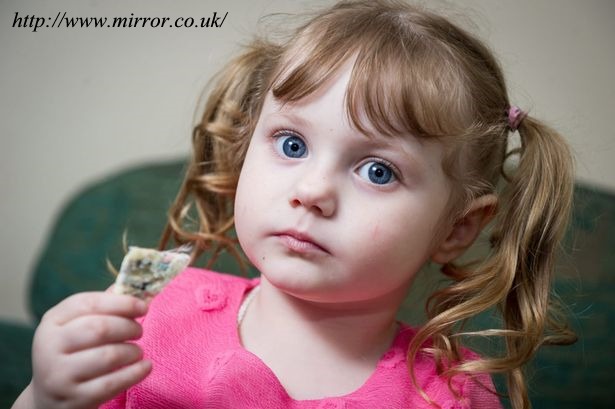
Eating her own carpet padding is a typical behavior for one child in England. Meet four-year old Jessica Knight of Cambridgeshire. Little Jessica has been struggling with a psychological condition known as Pica; a condition in which an individual craves and ingests non-nutritional substances, such as mud, chalk, paint, glue, etc.
Parents Kelly and Chris Knight were interviewed and reported that they were unaware of their daughter’s unusual habits at until Jessica was around 2 years old and was discovered eating her faux-leather chair. In response to her most recent Pica activity, Kelly expressed shock at the amount of Jessica’s carpet padding that was eaten away.
Jessica’s Pica behaviors combined with other food aversions have led to a dairy-rich diet lacking in iron. Jessica’s parents reported that they continue to remain positive and encouraging towards their daughter and to remind her that it’s okay to be different. Jessica’s parents reported that they have resorted to allowing Jessica to maintain a supply of carpet padding on-hand in order to aid in decreasing secretive eating and to help Jessica curb the cravings by allowing monitored ingestion.
Kelly reported that she was informed by doctors that Jessica’s pica was an eating disorder caused by cognitive impairments and that it would be untreatable until she was 6 or 7 years old. Jessica was identified as having an extremely high IQ and will be undergoing testing for autism this month.
What is Pica Exactly?
According to the American Psychological Association’s Diagnostic and Statistical Manual (DSM) 5, Pica is categorized as a Feeding and Eating Disorder and to be diagnosed with Pica a person must display:
· Persistent eating of non-nutritive substances for a period of at least one month.
· The eating of non-nutritive substances is inappropriate to the developmental level of the individual.
· The eating behavior is not part of a culturally supported or socially normative practice.
· If occurring in the presence of another mental disorder (e.g. autistic spectrum disorder), or during a medical condition (e.g. pregnancy), it is severe enough to warrant independent clinical attention.
Prevalence of Pica is difficult to measure due to hesitation by individuals to self-report abnormal eating behaviors, but it has been estimated to occur within 4-26% of the institutionalized population, making it more common in the cognitively impaired and disabled. It has been noted to occur across culture, race, and socioeconomic status, but is rarely seen in the healthy, general population.
Although seemingly innocent, Pica can result in serious health complications for the individual. The ingestion of non-nutritional substances can lead to iron-deficiency anemia, lead poisoning, malnutrition, digestive tract tears and pain, nutritional deficiencies (as individuals are missing vitamins and minerals normally received with ingestion of food), and even death—if left untreated.
Available Treatment
According to a recent study published in January 2015 from the Journal of Autism and Developmental Disorders, behavioral interventions have been identified as being highly effective in the treatment of Pica. This research aligns with most of the current practices currently utilized to treat Pica, which include: aversion therapy, positive reinforcement, discrimination training, psycho-education, psychotropic medications, Applied Behavioral Analysis (ABA) techniques, and other exposure therapy techniques.
Hope for the Future
Looking ahead, continued research is needed to gain further understanding of this rare condition and its etiology. As with any condition, education is an essential component in the prevention and early detection. One organization, Autism Speaks, has created a handy parent guide for Pica which provides education, signs and symptoms, and directives on seeking help. Unfortunately, as Pica tends to be a condition that is masked in secretive behavior, many parents may not learn of this information unless their child is already diagnosed with Autism or until Pica has already been diagnosed.
True as this is, there is hope; and the key is awareness. There are currently many mediums available to spread information including: print media, electronic, cinema, radio, etc. One such platform, social media, has been an integral part of the paradigm shift regarding how information is sent and received. This infusion has enabled awareness campaigns to spread fast and reach a vast audience worldwide. This possible avenue, combined with educational information distributed by the healthcare industry, educational institutions, mental health professionals, etc., can serve families like Jessica’s by equipping them with vital information that will enable them to tackle such challenges as they arise and provide hope for overcoming.
References
Call, N., Simmons, C., Lomas Mevers, J., & Alvarez, J. (2015). Clinical Outcomes of Behavioral Treatments for Pica in Children with Developmental Disabilities. Journal of Autism and Developmental Disorders. Retrieved April 7, 2015, from http://link.springer.com/article/10.1007/s10803-015-2375-z
New Pica Tool Kits from the Autism Speaks Autism Treatment Network! (n.d.). Retrieved April 6, 2015, from https://www.autismspeaks.org/blog/2014/05/30/new-pica-tool-kits-autism-speaks-autism-treatment-network
* Photo Retrieved April 10, 2015 from: http://www.mirror.co.uk/news/uk-news/meet-tot-who-ate-bedroom-5469177
About the Author
 Andrea Ruse, LCPC, LAC, CCDP-D, RPT
Andrea Ruse, LCPC, LAC, CCDP-D, RPTAndrea is the Clinical Supervisor and therapist at Preferred Family Healthcare in Olathe, KS. Her credentials include: Licensed Clinical Professional Counselor (KS), Licensed Addictions Counselor (KS), Certified Co-Occurring Disorders Professional-Diplomat (MO), and Registered Play Therapist. Her therapeutic orientations include: play therapy (ages 2-12), REBT, DBT, CBT, Family Systems Theory, and Client-Centered.
Office Location:
, Missouri
64064
United States
Phone: 8164009115
Contact Andrea Ruse
Professional Website:
aac.to/andy